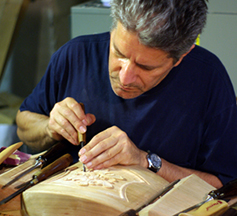
History I’ve been a woodworker for over thirty years, ten of them as a full time professional, but as the clichĂ© goes, I feel as though I’m still learning. I’ve made Victorian bars and Shaker benches and Nakashima-influenced tables and many small cabinets, and I’ve done a whole lot in between—pretty much anything in wood. I worked in large shops and small, did my share of furniture repair, and could not refuse plastic laminate work when it came along, although always to my regret. The money was too good, but luckily there came a time when it was not good enough. You can’t beat the variety of colors but working with plastic laminate is about the same to me as working with aluminum. My current shop is a hovel of a garage about a 20 minute drive from my house. I do rough work there, as well as sand and finish, while doing close work, cutting joints and such, in the basement of my small house. Less than ideal in both spaces, yes, and a far cry from the 1200 square feet of my first shop, but I manage. It’s like writing or any other art: if you feel the powerful urge to do it, you’ll find a way. I was the woodworker in an upholstery shop for a few years while earning a Master’s degree in English. Those were strange years, to say the least. I’d work in the upholstery shop most of the day and then go to classes, sometimes with sawdust in my pockets. One minute I was cutting out blanks on a band saw for cabriole legs, and the next I was in a bright classroom talking about Ernest Hemingway. I thought it peculiar then, bordering on an identity crisis, but it’s the norm for me now, since my “full time” job has me teaching English and writing at a large university. An hour or less after teaching, often you can find me working wood in the basement or in the garage. When I made the cabriole legs, I did so using the band saw and hand-shaping method, as opposed to turning them. I can do most woodworking tasks, but I never taught myself to turn or, for that matter, to steam bend or how to use a vacuum press for veneering. I’m not that big on using veneer to begin with, not the thin kind offered by the suppliers anyway and none that comes from a rain forest. Influences I love the work of Wharton Esherick, James Krenov, George Nakashima—those three titans—Sam Maloof, Greene and Greene, Harvey Ellis, and Shaker, but there’s very little woodwork, from the past or contemporary, that I don’t appreciate, although I tend to cast a dim eye on objects whose form is vastly greater than its function. I would say if I had to pick a favorite woodworker it would be Esherick; I like what I’ve read about his aesthetic and what I’ve seen. Before I became aware of Esherick, though, I had fallen under the spell of Krenov via the famous books he wrote. I still like him very much, but I have come to feel that he’s too formal, in the same way that I have come to feel that Nakashima is too organic, where his use of great slabs of wood seems wasteful to me now. This text was originally published in American Woodworker magazine. |